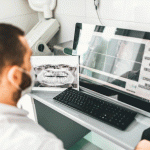If you’re considering having dental bone grafting surgery, but don’t really know what it’s all about or why it might be necessary, then you’ve come to the right place.
Clinique MFML is a maxillo facial clinic specializing in precisely this type of surgical intervention. In this article, we take a look at what a dental bone graft is, when it may be necessary, how the operation works and much more.
What is a dental bone graft?
A dental bone graft is a surgical procedure which will increase the amount of bone available in the jaw to support a future dental implant. When a person has lost a tooth or is suffering from bone atrophy for a variety of possible reasons, a dental bone graft may be necessary to create a solid base on which to install a dental implant.
When is a bone graft necessary?
Bone grafting is usually recommended in the following situations:
- When there is insufficient bone in the jaw
- Before a dental implant is installed, to ensure long-term stability
- To repair bone damage resulting from infection or injury.
Of course, dental bone grafting may not always be necessary. During your appointment, one of our surgeons will take the time to consider whether or not this procedure is the best treatment for your unique situation. It’s important to choose a clinic you can trust, because dental bone grafting is more expensive than any other dental procedure.
What happens during a dental bone graft?
The dental bone grafting procedure is divided into three stages: before, during and after the surgery.
Let’s take a look at the different stages.
Before dental bone graft surgery
Prior to the surgery, you will meet with your maxillo-facial surgeon to discuss the procedure, your medical history and, most importantly, your needs. We will also take an image of your jaw using our 3D radiology equipment to assess the quality of the existing bone.
During dental bone graft surgery
The intervention itself will performed under local, or possibly general anaesthetic, depending on the complexity of the graft. During the operation, the surgeon usually removes bone from another area of the body or uses artificial bone material, and inserts it into the jaw. Once the bone is in place, sutures are put in place to close the wound.
After dental bone graft surgery
The recovery period after a dental bone graft varies according to the complexity of your operation. You may experience some discomfort, but most patients return to normal daily life within a few days. Following your surgeon’s post-operative instructions is essential to your recovery.
What is the recovery time following a dental bone graft?
Recovery time may vary from patient to patient, but in general, it takes several months for the new bone to “fuse” securely to the jawbone. Following your operation, we’ll schedule a series of follow-up appointments to verify that the graft is healing well.
What are the risks involved in dental bone grafting?
Like all surgical procedures, bone grafting presents certain risks. The most common are:
- Risk of infection
- The appearance of a hematoma (severe bruising)
- Rejection of grafted bone or complications related to anesthesia
However, with an experienced surgeon and good preparation, these risks are generally reduced.
Book a consultation now!
If you’re experiencing a toothache or need bone grafting, please make an appointment with our team. We’re here to guide you through the process and provide you with quality care.
Your oral health is our priority! Contact us today to learn more about dental bone grafting.




